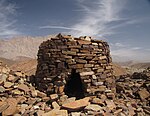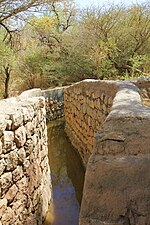List of World Heritage Sites in Oman
The United Nations Educational, Scientific and Cultural Organization (UNESCO) designates World Heritage Sites of outstanding universal value to cultural or natural heritage which have been nominated by signatories to the 1972 UNESCO World Heritage Convention.[1] Cultural heritage consists of monuments (such as architectural works, monumental sculptures, or inscriptions), groups of buildings, and sites (including archaeological sites). Natural features (consisting of physical and biological formations), geological and physiographical formations (including habitats of threatened species of animals and plants), and natural sites which are important from the point of view of science, conservation or natural beauty, are defined as natural heritage.[2] Oman accepted the convention on 6 October 1981, making its historical sites eligible for inclusion on the list. It has five World Heritage Sites and a further seven sites on the tentative list.[3]
The first site listed in Oman was the Bahla Fort in 1987, while the most recent one was the Ancient City of Qalhat in 2018. All five sites are listed for their cultural significance. Bahla Fort was listed as endangered in 1988 because of the degradation of the structure. In 2004, after reconstruction, it was removed from the endangered list.[4] Oman has served on the World Heritage Committee three times.[3]
World Heritage Sites[edit]
UNESCO lists sites under ten criteria; each entry must meet at least one of the criteria. Criteria i through vi are cultural, and vii through x are natural.[5]
| Site | Image | Location (governorate) | Year listed | UNESCO data | Description |
|---|---|---|---|---|---|
| Bahla Fort | 
|
Ad Dakhiliyah | 1987 | 433; iv (cultural) | The large mudbrick fort and the adjacent small oasis settlement date to the late Middle Ages, between the 12th and 15th centuries, and were constructed by the Banu Nebhan tribe. Bahla was the centre of Ibadi Islam. The fort is a pre-gunpowder building with round watchtowers and castellated parapets. Due to deterioration of the structure, the site was listed as endangered in 1988. Upon reconstruction, it was removed from the endangered list in 2004.[4] |
| Archaeological Sites of Bat, Al-Khutm and Al-Ayn | 
|
Al Dhahirah | 1988 | 434; iii, iv (cultural) | This site comprises three clusters of ancient necropolises and settlements from the Early Bronze Age, in the 3rd millennium BCE. During that period, the area was important for extraction of copper which was exported to Mesopotamia and possibly to the Indus Valley. The earliest constructions are in mudbrick while later are made with cut stone. Tombs from different periods have different styles. There are beehive tombs, dry-stone cairn tombs, small single-chambered, and elaborate multi-chambered tombs. A mound at Al-Ayn is pictured.[6] |
| Land of Frankincense | 
|
Dhofar | 2000 | 1010; iii, iv (cultural) | Frankincense, resin of the Boswellia sacra tree (pictured), was one of the most important luxury items of the Classical antiquity. This site comprises Wadi Dawkah where frankincense was collected, a trading post and caravan supply station at Shisr, and ports of Khor Rori and Al-Baleed which were heavily fortified. Khor Rori started to decline in the 5th century while Al-Baleed lost its role with the arrival of European trade in the 15th century.[7] The site was originally listed as The Frankincense Trail but renamed to its present name in 2005.[8] |
| Aflaj Irrigation Systems of Oman | 
|
Ad Dakhiliyah, Al Batinah, Ash Sharqiyah South | 2006 | 1207; v (cultural) | Aflaj is a traditional irrigation system in Oman that has been in use since at least the year 500. Groundwater or spring water is collected and delivered through a series of underground or surface channels to the settlements for domestic or agricultural purposes. The enclosed settlements, forts, palaces, watchtowers, and temporary dwellings used during the date harvest shape the cultural landscape that was made possible by irrigation of this otherwise harsh and very dry desert land. There are around 3,000 functioning aflaj systems in Oman that still provide a large part of the water used in the country. The World Heritage Site comprises five representative sites, Falaj Daris is pictured.[9] |
See also[edit]
References[edit]
- ^ "The World Heritage Convention". UNESCO World Heritage Centre. Archived from the original on 27 August 2016. Retrieved 21 September 2010.
- ^ "Convention Concerning the Protection of the World Cultural and Natural Heritage". UNESCO World Heritage Centre. Archived from the original on 1 February 2021. Retrieved 3 February 2021.
- ^ a b "Oman". UNESCO World Heritage Centre. Retrieved January 8, 2024.
- ^ a b "Bahla Fort". UNESCO World Heritage Centre. Retrieved January 8, 2024.
- ^ "UNESCO World Heritage Centre – The Criteria for Selection". UNESCO World Heritage Centre. Archived from the original on 12 June 2016. Retrieved 17 August 2018.
- ^ "Archaeological Sites of Bat, Al-Khutm and Al-Ayn". UNESCO World Heritage Centre. Retrieved January 8, 2024.
- ^ "Land of Frankincense". UNESCO World Heritage Centre. Retrieved January 8, 2024.
- ^ "Decision 29 COM 8B.2 Changes to Names of Properties (The Land of Frankincense)". UNESCO World Heritage Centre. Retrieved January 8, 2024.
- ^ "Aflaj Irrigation Systems of Oman". UNESCO World Heritage Centre. Retrieved January 8, 2024.



